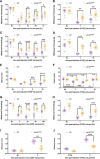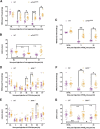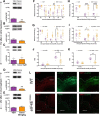The MNK-eIF4E Signaling Axis Contributes to Injury-Induced Nociceptive Plasticity and the Development of Chronic Pain
- PMID: 28674170
- PMCID: PMC5546114
- DOI: 10.1523/JNEUROSCI.0220-17.2017
The MNK-eIF4E Signaling Axis Contributes to Injury-Induced Nociceptive Plasticity and the Development of Chronic Pain
Abstract
Injury-induced sensitization of nociceptors contributes to pain states and the development of chronic pain. Inhibiting activity-dependent mRNA translation through mechanistic target of rapamycin and mitogen-activated protein kinase (MAPK) pathways blocks the development of nociceptor sensitization. These pathways convergently signal to the eukaryotic translation initiation factor (eIF) 4F complex to regulate the sensitization of nociceptors, but the details of this process are ill defined. Here we investigated the hypothesis that phosphorylation of the 5' cap-binding protein eIF4E by its specific kinase MAPK interacting kinases (MNKs) 1/2 is a key factor in nociceptor sensitization and the development of chronic pain. Phosphorylation of ser209 on eIF4E regulates the translation of a subset of mRNAs. We show that pronociceptive and inflammatory factors, such as nerve growth factor (NGF), interleukin-6 (IL-6), and carrageenan, produce decreased mechanical and thermal hypersensitivity, decreased affective pain behaviors, and strongly reduced hyperalgesic priming in mice lacking eIF4E phosphorylation (eIF4ES209A ). Tests were done in both sexes, and no sex differences were found. Moreover, in patch-clamp electrophysiology and Ca2+ imaging experiments on dorsal root ganglion neurons, NGF- and IL-6-induced increases in excitability were attenuated in neurons from eIF4ES209A mice. These effects were recapitulated in Mnk1/2-/- mice and with the MNK1/2 inhibitor cercosporamide. We also find that cold hypersensitivity induced by peripheral nerve injury is reduced in eIF4ES209A and Mnk1/2-/- mice and following cercosporamide treatment. Our findings demonstrate that the MNK1/2-eIF4E signaling axis is an important contributing factor to mechanisms of nociceptor plasticity and the development of chronic pain.SIGNIFICANCE STATEMENT Chronic pain is a debilitating disease affecting approximately one in three Americans. Chronic pain is thought to be driven by changes in the excitability of peripheral nociceptive neurons, but the precise mechanisms controlling these changes are not elucidated. Emerging evidence demonstrates that mRNA translation regulation pathways are key factors in changes in nociceptor excitability. Our work demonstrates that a single phosphorylation site on the 5' cap-binding protein eIF4E is a critical mechanism for changes in nociceptor excitability that drive the development of chronic pain. We reveal a new mechanistic target for the development of a chronic pain state and propose that targeting the upstream kinase, MAPK interacting kinase 1/2, could be used as a therapeutic approach for chronic pain.
Keywords: MNK1; MNK2; chronic pain; dorsal root ganglion; eIF4E; nociceptor.
Copyright © 2017 the authors 0270-6474/17/377482-19$15.00/0.
Figures












Similar articles
-
ephrin-B2 promotes nociceptive plasticity and hyperalgesic priming through EphB2-MNK-eIF4E signaling in both mice and humans.Pharmacol Res. 2024 Aug;206:107284. doi: 10.1016/j.phrs.2024.107284. Epub 2024 Jun 24. Pharmacol Res. 2024. PMID: 38925462 Free PMC article.
-
Nociceptor Translational Profiling Reveals the Ragulator-Rag GTPase Complex as a Critical Generator of Neuropathic Pain.J Neurosci. 2019 Jan 16;39(3):393-411. doi: 10.1523/JNEUROSCI.2661-18.2018. Epub 2018 Nov 20. J Neurosci. 2019. PMID: 30459229 Free PMC article.
-
IL-6 induced upregulation of T-type Ca2+ currents and sensitization of DRG nociceptors is attenuated by MNK inhibition.J Neurophysiol. 2020 Jul 1;124(1):274-283. doi: 10.1152/jn.00188.2020. Epub 2020 Jun 10. J Neurophysiol. 2020. PMID: 32519575 Free PMC article.
-
Mitogen-activated Protein Kinase (MAPK) Interacting Kinases 1 and 2 (MNK1 and MNK2) as Targets for Cancer Therapy: Recent Progress in the Development of MNK Inhibitors.Curr Med Chem. 2017;24(28):3025-3053. doi: 10.2174/0929867324666170203123427. Curr Med Chem. 2017. PMID: 28164761 Review.
-
Dual targeting of eIF4E by blocking MNK and mTOR pathways in leukemia.Cytokine. 2017 Jan;89:116-121. doi: 10.1016/j.cyto.2016.01.024. Epub 2016 Apr 16. Cytokine. 2017. PMID: 27094611 Free PMC article. Review.
Cited by
-
Neuroendocrine Mechanisms Governing Sex Differences in Hyperalgesic Priming Involve Prolactin Receptor Sensory Neuron Signaling.J Neurosci. 2020 Sep 9;40(37):7080-7090. doi: 10.1523/JNEUROSCI.1499-20.2020. Epub 2020 Aug 12. J Neurosci. 2020. PMID: 32801151 Free PMC article.
-
MNK1 and MNK2 expression in the human dorsal root and trigeminal ganglion.bioRxiv [Preprint]. 2023 Jan 4:2023.01.04.522773. doi: 10.1101/2023.01.04.522773. bioRxiv. 2023. Update in: Neuroscience. 2023 Apr 1;515:96-107. doi: 10.1016/j.neuroscience.2023.01.039. PMID: 36711529 Free PMC article. Updated. Preprint.
-
The antidiabetic drug metformin prevents and reverses neuropathic pain and spinal cord microglial activation in male but not female mice.Pharmacol Res. 2019 Jan;139:1-16. doi: 10.1016/j.phrs.2018.10.027. Epub 2018 Nov 1. Pharmacol Res. 2019. PMID: 30391353 Free PMC article.
-
A pharmacological interactome between COVID-19 patient samples and human sensory neurons reveals potential drivers of neurogenic pulmonary dysfunction.Brain Behav Immun. 2020 Oct;89:559-568. doi: 10.1016/j.bbi.2020.05.078. Epub 2020 Jun 1. Brain Behav Immun. 2020. PMID: 32497778 Free PMC article.
-
Electrically-evoked oscillating calcium transients in mono- and co-cultures of iPSC glia and sensory neurons.Front Cell Neurosci. 2023 Mar 16;17:1094070. doi: 10.3389/fncel.2023.1094070. eCollection 2023. Front Cell Neurosci. 2023. PMID: 37006467 Free PMC article.
References
-
- Altman JK, Szilard A, Konicek BW, Iversen PW, Kroczynska B, Glaser H, Sassano A, Vakana E, Graff JR, Platanias LC (2013) Inhibition of Mnk kinase activity by cercosporamide and suppressive effects on acute myeloid leukemia precursors. Blood 121:3675–3681. 10.1182/blood-2013-01-477216 - DOI - PMC - PubMed
MeSH terms
Substances
Grants and funding
LinkOut - more resources
Full Text Sources
Other Literature Sources
Medical
Molecular Biology Databases
Miscellaneous
